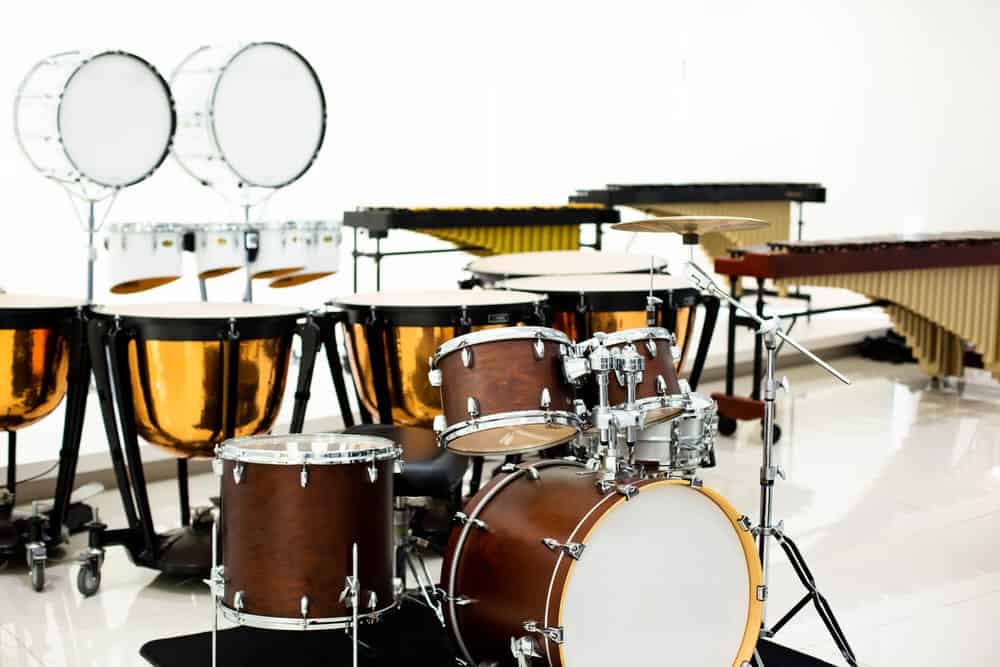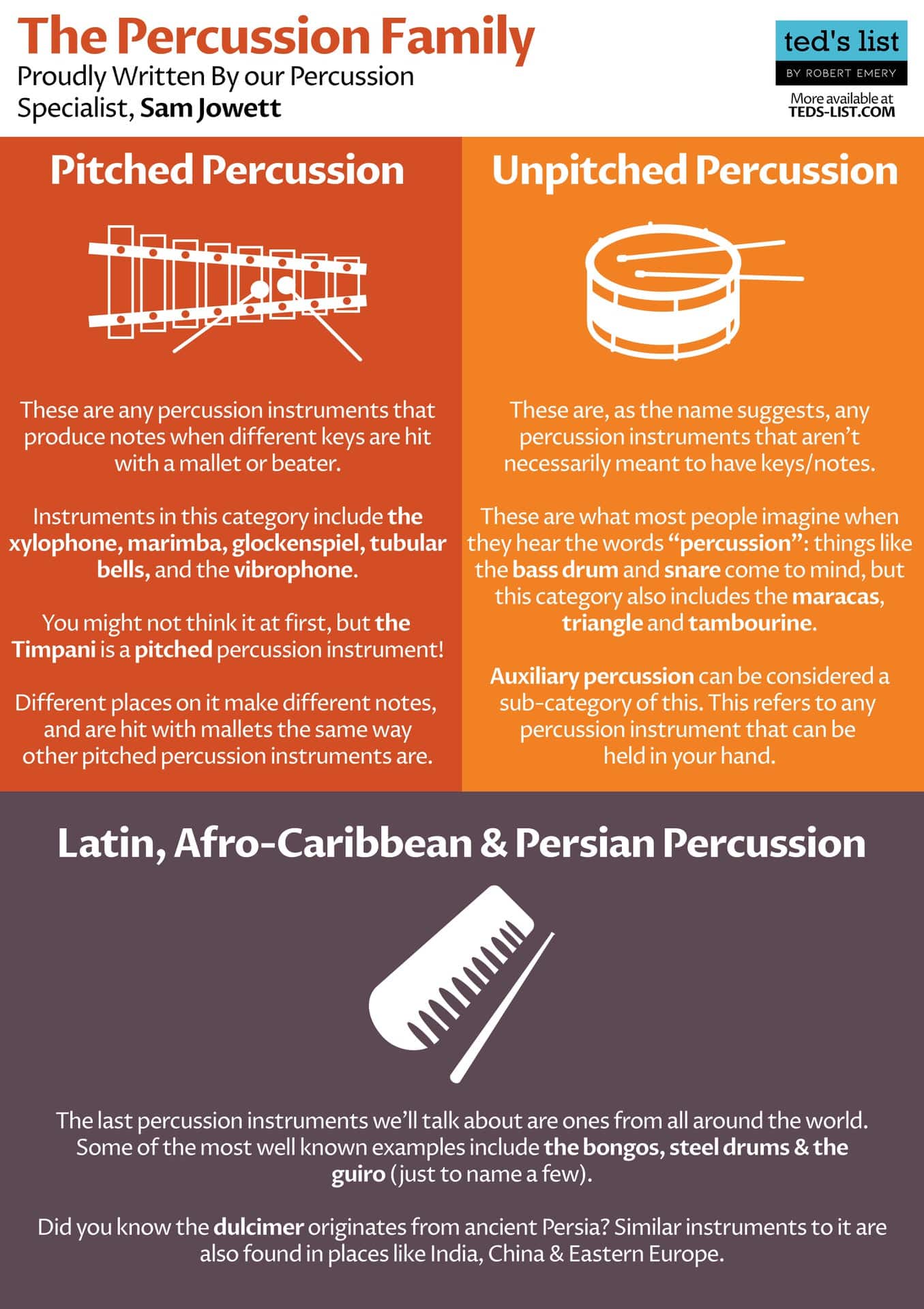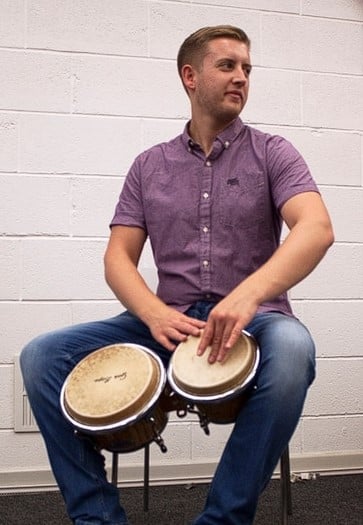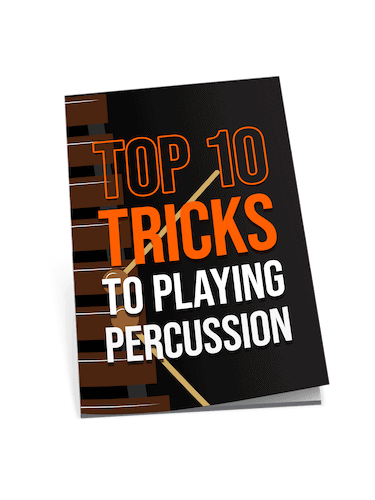The percussion instruments list consists of various instruments that produce sound through striking or shaking.
Percussionists play a huge array of percussion instruments. The percussion family of musical instruments can be divided into two categories; pitched and un-pitched percussion, with further subcategories blending between the two.
The list of percussion instruments includes the drum set, tambourine, maracas, cymbals, gong, xylophone, and triangle. These instruments are commonly used in various musical genres and are often seen in orchestras, marching bands, and rock bands.
Carry on reading to explore the percussion family instruments and find out what makes them ting, boom and crash!
All percussion instruments don’t only deliver rhythm, but melody and harmony too. A percussionist can produce many different sounds and effects, because the percussion instruments are made of all sorts of materials, and the mallets are too. Click here to read our article about how to choose the right musical instruments from the percussion family for you.
The pitch percussion instruments has a definite pitch and distinctive sound, whereas unpitched percussion (although it may produce a pitch) will be unpredictable, and can change.
Many percussion instruments are idiophones. An idiophone is an instrument where the material vibrates to create the initial sound. Some examples are the xylophone, cymbals, triangle and gong.
Sabian Artisan 18”
Crash Natural
A great addition to the drum kit or a percussion set up
-
Suitable for: All music settings
-
Design: 18” Hand Hammered
- Dark, Complex and Smooth Tone
- Great for light and heavy playing
- A tried and tested brand
- Premium Price Tag
8” Bronze Triangle
by Sabian
A must-have for every percussionist
-
Suitable for: All symphonic settings
-
Design: 8” B8 Bronze
- Medium-low pitched sound
- Bright and focused sound
- Clear overtones
- Limited dynamic range
Pitched percussion instruments
The pitched percussion instruments list (also known as tuned percussion) includes the xylophone, marimba, glockenspiel (also known as bells), tubular bells (also known as chimes) and vibraphone (which has a pedal). These percussion instruments produce many pitches. We call these pitches ‘notes’, and the player needs to strike or hit various notes (also known as bars or keys) to play a melody or harmony.
Some tuned percussion family instruments have resonators underneath each note to amplify the sound. The use of pitched instruments in music dates back centuries, providing a rich musical expression and innovation history.
The xylophone and marimba are similar in construction. They both have wooden bars and use resonators. The biggest difference is the sound they make. The xylophone is bright and higher in pitch, whereas marimbas are much richer in tone. This is mainly down to the size of the keys. Generally speaking, a harder mallet or beater is used when striking the xylophone, and the marimba is popular for solo playing.
3.5 Octave Xylophone
by Yamaha
BRILLIANT XYLOPHONE AT REASONABLE COST
-
Suitable for: Lower Graded students
-
Design: 3.5 Octaves, Padauk Bars
- Height Adjustable
- Compact Size
- An established and trusted brand
- The smaller bars create a lesser quality tone and dynamic range
The glockenspiel (also known as bells) is one of the smaller tuned percussion instruments and the keys are metallic. It is used in many musical settings from full symphonic works to musical theatre and military bands. It is also particularly popular for use in schools because they can come in such a small set, ideal for little hands!
Glockenspiel-Silver-
Keys/14X5
Performance Percussion Glockenspiel
-
Key Feature: Compact Design
-
Includes: Beaters
- HANDY CASE FOR EASY TRANSPORT
- Durable case
- Great introductory set
- This will be quickly out-grown
Drums are not usually thought of as pitched percussion instruments, however, Timpani are classed as drums and there are other world instruments that create pitches. The timpani are most commonly played alongside the percussion section of an orchestra.
WHD Timpani Set
GREAT STARTER SET-
Key Feature: Lightweight
-
Includes: Padded Covers and Mallets
- Remo heads as standard
- Come with high quality Remo heads
- Great entry-level option
- Fibreglass bowls produce a lower quality tone
Unpitched percussion instruments
TWO
Un-pitched percussion includes the snare drums and large bass drums, triangle, tambourine, and maracas. The origin of these instruments stretch across the globe and are often used in many of our ensembles.
The bass drum is the largest drum, and because of its size it creates the lowest pitch.
WHD 36'' X 18''
Concert Bass Drum
A great all-rounder
-
Suitable for: Orchestral Settings
-
Design: 36"
- Tilting Stand and Cymbal Holder
- Fully rotatable allowing for any playing angle.
- Attachment for cymbals gives the option of ‘machine’ work.
- The standard head is Fibreskyn, although these are arguably the best choice for a man made material, they do not have the same level of depth and dryness as calfskin.
The snare drum creates its unique sound from the snares (metal coils), which are pressed against the snare head, which then vibrate to create a ‘buzz’.
Gretsch Full
Range 14" x 5"
Black Nickel Over
Steel Snare
A great all-rounder
-
Suitable for: All music settings
-
Design: 14” x 5”
- 45 Degree Bearing Edges which offers a modern attack with great projection
- Wide Tuning Range
- Modern Tone
- World renowned brand
- Not the most sensitive drum for quiet orchestral playing
The two drums I’ve just mentioned are central to a marching band, because they set and maintain the tempo.
You can use all sorts of sticks and mallets to produce sound, as well as using your hands. Choosing what to use depends on many things, including the volume and timbre you want to achieve. Even the venue you are playing influences your decision, because the sound you make will come across to your audience differently depending on the acoustic.
We can also split un-pitched percussion into another group of hand-held percussion, or auxiliary percussion. This describes any of the percussion instruments that is held in your hand. It’s a useful term for musicians and composers, because it eliminates other percussion instruments such as timpani and the xylophone. Many of our most common hand held instruments are from Latin America.
Latin/Afro-Caribbean and Persian percussion
Three
As well as Latin America, Latin percussion also includes instruments from Spain and Portugal.
Possibly the most well known of these instruments are the bongos. Originating from central Africa, the bongos are a relatively new musical instrument which are widely used in Cuba in music such as Salsa.
Check out this video featuring some latin percussion family instruments:
Meinl Percussion
Free Ride Designer
6 ¾” & 8” Bongos
Perfect for the working musician.
-
Suitable for: All music settings
-
Design: 6 ¾” & 8” Wood Bongos
- More features: Made with Siam Oak giving a really warm tone
- Includes an accessory pouch, tuning key and tune-up oil
- The design of the rims and lugs provide consistent tuning
- Premium price tag
You will no doubt recognize the unmistakable sound of the steel pans which originate from Trinidad and Tobago. Claves and the Guiro are more examples and of course, there is always room for more Cowbell!
Meinl Wood Claves
A staple for Latin Music-
Suitable for: All music settings
-
Design: Solid Redwood
- More features: Identical size provides a consistent tone
- Includes an accessory pouch, tuning key and tune-up oil
- The design of the rims and lugs provide consistent tuning
- Not as bright as other types
Nino Guiro
An important part of a percussion set-up-
Suitable for: All music settings
-
Design: Rubber wood with wooden striker
- Tonal Grooves create different sound when struck
- Versatile Sounds
- Durable construction
- None
Tycoon 6” Black
Powder Mountable
Cowbell
An important part of a percussionists set-up
-
Suitable for: All music settings
-
Design: Black Powder Coated Finish
- Solid construction from high quality steel
- Rich, bright tone
- Mountable
- Premium Price Tag
The Persian Dulcimer is steeped in history and similar instruments can be found in India, China and Eastern Europe. It is a stringed instrument that is struck with oval shaped mallets, and interestingly this uses the same principle as a piano.
The Darbuka (also known as a Doumbek or a Tumbak) is a small goblet shaped drum. The techniques used to make the sound are intricate and mainly use the fingers. It can be positioned under one arm, placed on the lap or suspended with a strap.
Meinl 8 ½ “ Copper Doumbek
Suitable For: Folkloric Music-
Suitable for: Professional players
-
Design: Hand Engraved Shell
- Internal Tuning Lugs
- Wide range of timbres
- Durable construction
- Premium Price Tag
Percussion family instruments
Summary
Determining whether or not an instrument from the percussion family is pitched or un-pitched depends on its ability to make a definite pitch. We have also explored subcategories of these groups of percussion, which were Latin/Afro-Caribbean Percussion and Persian Percussion.
There is such a vast number of instruments within the percussion family, and many of them share the same or similar techniques. This is why a percussionist can often turn their hand to many of these instruments.

Best Glockenspiel for Beginners
Glockenspiel-Silver-
Keys/14X5
A compact design, and also includes your first pair of beaters!

Best Snare Drum for Orchestra Playing
Gretsch Full Range 14" x 5" Black Nickel Over Steel Snare
A stunning sounding drum from one of the biggest names in the business!

Best Hand Percussion Instrument for Beginners
Meinl Percussion Free Ride Designer 6 3/4" & 8" Bongos
Great sounding bongos from a trusted brand.
FAQ's
The four main percussion family instruments are Bass Drum, Snare, Timpani and Xylophone
Pitched percussion instruments produce specific musical notes, like xylophones and marimbas, while unpitched percussion instruments, such as cymbals and snare drums, produce sound without a specific pitch.
There are literally thousands of different types of percussion family instruments, originating from every corner of the globe.
The main six families of instruments are strings, woodwind, brass, percussion, keyboards and voice.
There are two main types of percussion family instruments. These are pitched percussion, where the instrument creates definite pitches (such as a glockenspiel or bells), and un-pitched percussion where the instrument does not create a definite pitch (such as a snare drum).
No, you cannot tune a triangle. The triangle is a percussion instrument that produces a single, high-pitched note when struck with a beater.













My son had a school project and this article helped a ton.
Hi Kelly, I’m pleased we helped. If you need anything else, just ask!